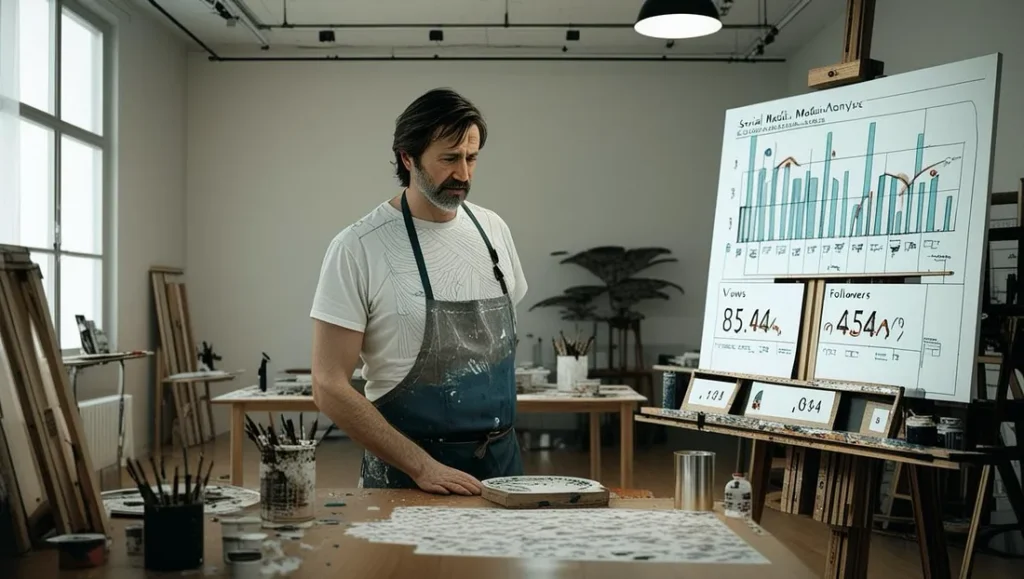Digital devices permeate our daily lives and are far more than neutral tools. They not only enable the production and consumption of art but also carry the ideological marks of neoliberalism, shaping desires, values, and forms of creation. In a constant interplay between autonomy and control, these technologies act as silent—and often disguised—mediators of market logic.
Governance of Desire and Algorithms
Algorithms, those invisible codes that govern behavior on digital platforms, present themselves as mere information organizers, but they are also engines of desired governance. Instead of spontaneous social norms, we find systems that manipulate and amplify individual preferences with surgical precision, transforming tastes and interests into monetizable data. Artistic practice, venturing into this terrain, often adapts to these dynamics, seeking visibility in an environment where the “favor” of the algorithm is essential.
The commodification of Expression and Art
In the era of social networks, the value of art is measured not by its intrinsic content but by its ability to engage. Likes, shares, and views become the currency of a symbolic market where art is reduced to a product of quick consumption and disposability. The paradox is evident: while platforms promise to “democratize” artistic creation, they also impose a validation system that privileges popularity over depth.
Networks and Connections: Between Collaboration and Control
Digital networks are often celebrated as spaces for global communication, but they also function as surveillance and control tools. Every click and connection feeds an infrastructure that tracks, analyzes, and monetizes social relationships. The artist transformed into a node within this network, is encouraged to act individualistically, reflecting the neoliberal values of competition and self-entrepreneurship.
Digital Activism: Resistance or Reproduction?
Digital platforms also provide space for activism and resistance, but not without ambivalence. While they enable the organization of transnational movements, these spaces often reproduce the same neoliberal values they seek to challenge. Personal branding and performative engagement become central elements of activism, creating tensions between the pursuit of collective change and the dynamics of self-promotion.
Critical Appropriation and Subversion
Contemporary artists have used digital technologies as instruments of critique and subversion. However, the very infrastructure of these tools is imbued with capitalist logic that shapes their use and creation. Even in resistance, artists often end up reinforcing neoliberal structures, a tension that highlights the power of technologies to capture even the most rebellious gestures.
The Aesthetics of Software
In the realm of digital creation, the aesthetics of software present new possibilities for art, valuing interactive processes and numerical language. Here, the concept and generative process take precedence over the final object. However, this “freedom” is limited by the very systems that govern the software: code restrictions, platform dependencies, and market priorities.
The Digital as an Extension of the Market
Perhaps the most evident aspect of the relationship between digital technology and neoliberalism is the transformation of platforms into total markets. Here, every interaction is capitalized, every piece of data is a resource, and every cultural experience becomes part of an attention economy. The illusion of digital neutrality fades when we realize that the design of algorithms and interfaces is not just technical but also ideological.
Conclusion: Between Navigation and Resistance
Digital technologies, far from being neutral tools, are active agents in mediating neoliberal ideologies in artistic practice. They offer artists both challenges and opportunities: they can be used to critique and resist neoliberalism but also to reproduce it. The dilemma is clear: how to navigate these platforms without fully surrendering to their logic? Perhaps the answer lies in critical exploration, creative subversion, and the construction of alternative spaces for creation and sharing.
Victor T. Murari
Art History, Education & Artificial Intelligence | PhD | Advancing Educational and Cultural Narratives through AI Integration

